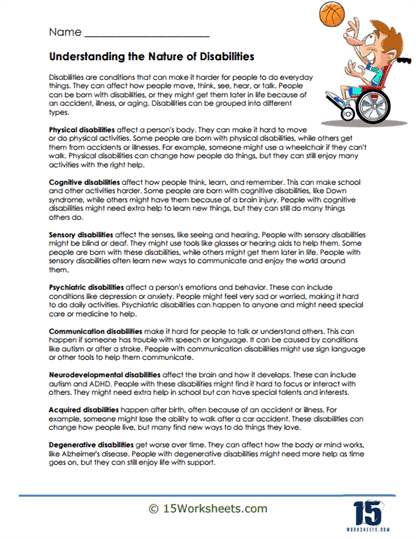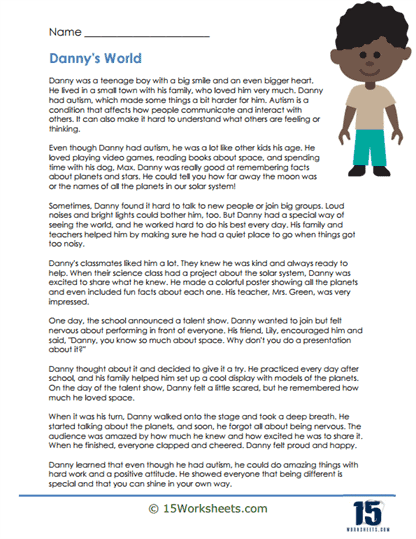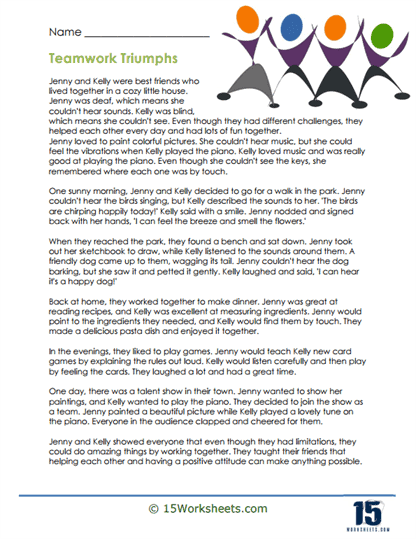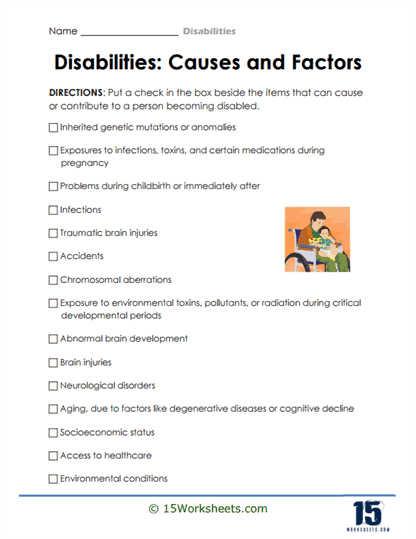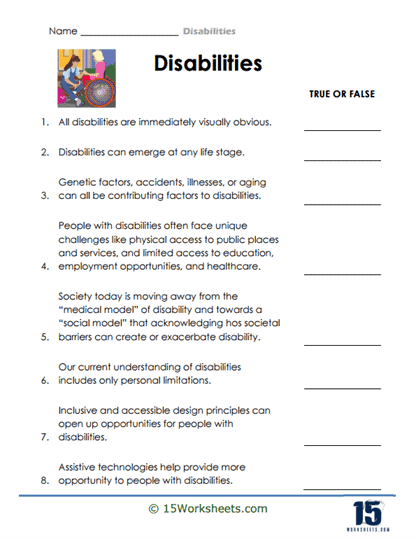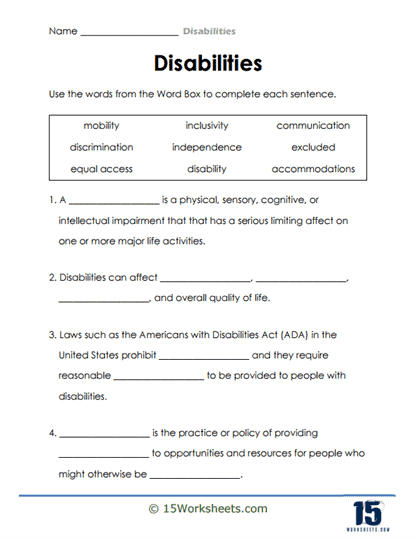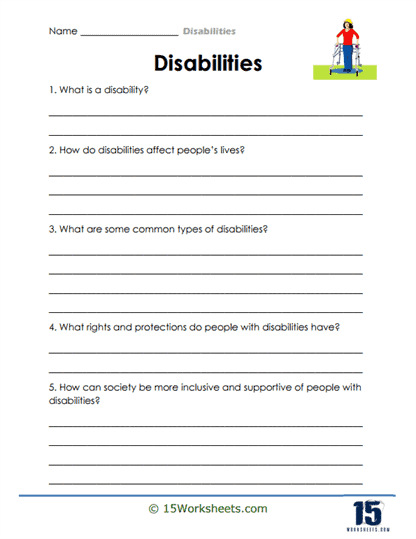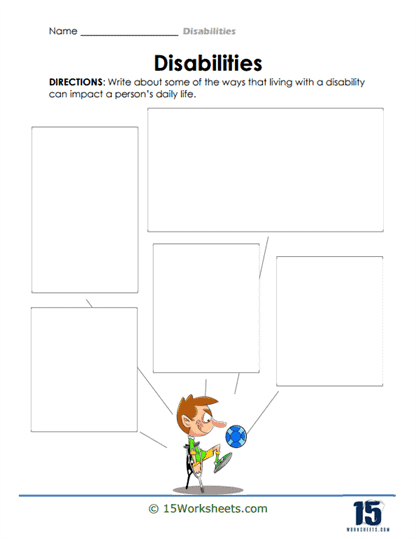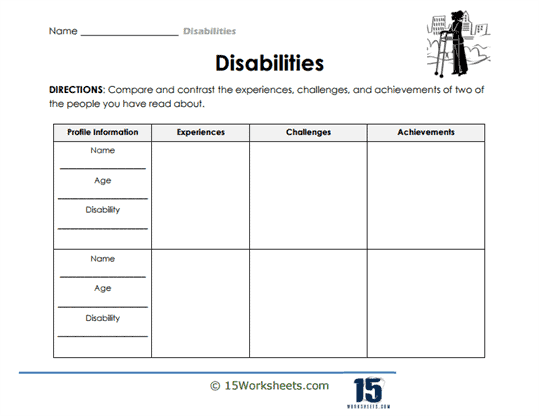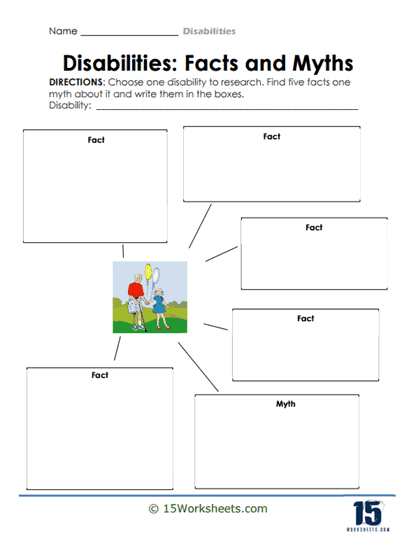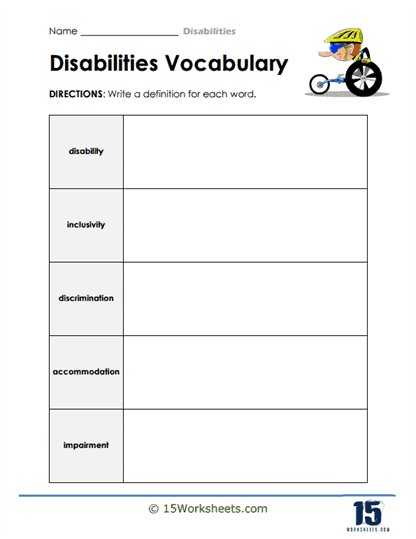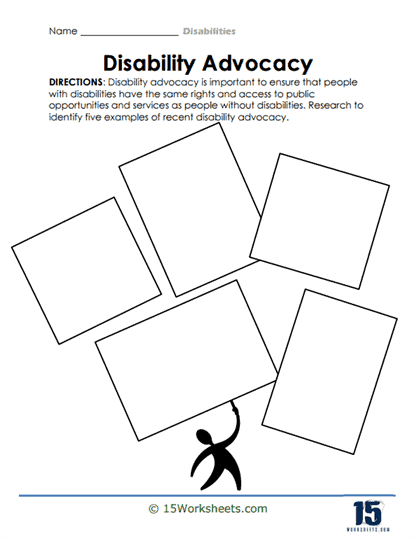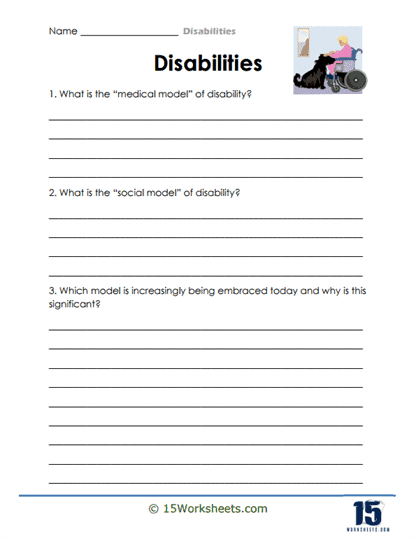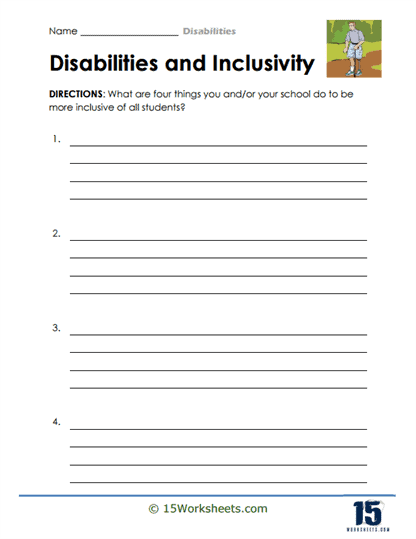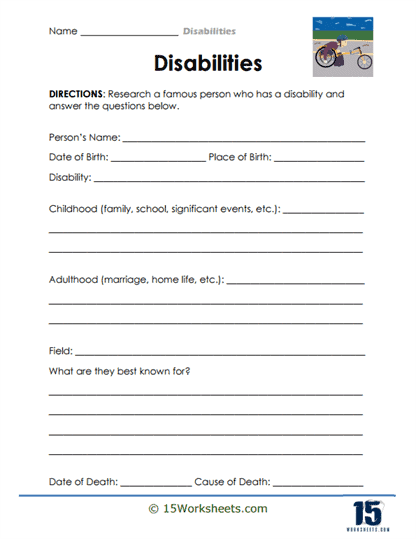Disability Worksheets
About These 15 Worksheets
This collection of worksheets is a comprehensive educational resource designed to enhance understanding and empathy among students regarding various types of disabilities. These worksheets are ideal for classroom use, homeschooling, and any educational environment focused on inclusive learning. Each worksheet is available in PDF format, making it convenient for teachers, parents, and students to view, download, and print as needed.
The worksheets in this collection cover a broad spectrum of disabilities, offering both informative content and engaging activities. The first set of worksheets focuses on Disability Terminology, where students are encouraged to define key terms related to disabilities in their own words. This activity not only familiarizes students with the vocabulary but also encourages them to think critically about what each term means.
Another set of worksheets emphasizes the Classification of Disabilities. In these worksheets, students sort different disabilities into categories such as Communication, Sensory, Cognitive, Physical, Neurological, and Mental Health. This classification exercise helps students understand the diverse nature of disabilities and how they impact different aspects of life.
For those looking to delve deeper into the subject, the worksheets on Understanding the Nature of Disabilities provide detailed descriptions of various types of disabilities, including physical, cognitive, sensory, psychiatric, communication, neurodevelopmental, acquired, and degenerative disabilities. These worksheets come with accompanying reading comprehension questions to reinforce learning and ensure students grasp the material.
The collection also includes thought-provoking Discussion Worksheets that pose essential questions like “What is a disability?”, “How do disabilities affect people’s lives?”, and “What rights and protections do people with disabilities have?” These questions are designed to stimulate class discussions and encourage students to think deeply about the societal impact of disabilities and the importance of inclusion.
Another key feature of this series is the Assistive Technologies and Support Systems worksheet. This worksheet prompts students to explore the significance of assistive technologies, universal design, adaptive strategies, and social support networks in improving the lives of individuals with disabilities. Students are asked to provide examples, making the activity both informative and practical.
There are worksheets that explore causes and factors contributing to disabilities. These worksheets help students understand the various genetic, environmental, and accidental factors that can lead to disabilities. This knowledge fosters empathy and raises awareness about the challenges faced by individuals with disabilities.
Moreover, the collection includes True or False activities that debunk common myths about disabilities, ensuring students develop a well-rounded understanding of the topic. These activities challenge students to think critically about preconceived notions and encourage a more inclusive mindset.
To further engage students, the collection offers Fill-in-the-Blank worksheets where students use a word box to complete sentences related to disabilities. This reinforces key concepts and terminology while providing a fun and interactive learning experience.
The series offers a balanced mix of factual information, critical thinking exercises, and engaging activities, all aimed at fostering a deeper understanding of disabilities. By incorporating these worksheets into their curriculum, educators can help students develop empathy, awareness, and a commitment to inclusivity in their everyday lives.
What Are Disabilities?
Disabilities are conditions that affect how a person performs everyday activities. They can influence a wide range of functions, including movement, communication, learning, and sensory experiences like seeing or hearing. Disabilities can vary greatly in terms of severity and impact; some individuals may need extensive support in their daily lives, while others might require only minor adjustments to their environment or routine. It’s important to understand that having a disability does not define a person’s potential or limit their ability to lead a fulfilling life. With the right support and accommodations, individuals with disabilities can achieve great things.
People can acquire disabilities in several ways. Some individuals are born with disabilities due to genetic factors, developmental issues, or conditions present at birth. For instance, Down syndrome is a genetic disorder that is present from birth and affects intellectual and developmental functions. Others may develop disabilities later in life due to accidents, illnesses, or aging. For example, a person might experience hearing loss after a severe ear infection, or someone could become paralyzed due to a spinal cord injury from a car accident. Disabilities can also be acquired gradually over time, such as the progressive loss of vision due to degenerative conditions like macular degeneration.
There are several major types of disabilities that children might encounter among their classmates:
Physical – These affect a person’s ability to move or perform physical tasks. Examples include muscular dystrophy, which weakens muscles over time, and cerebral palsy, which affects movement and muscle coordination. A classmate with a physical disability might use a wheelchair or have difficulty with activities like running or writing.
Cognitive – Cognitive disabilities affect how a person learns, thinks, and processes information. Examples include intellectual disabilities, where a person might take longer to learn new skills, and conditions like dyslexia, which makes reading and writing more challenging. Children with cognitive disabilities may need extra help in school but can still succeed with the right support.
Sensory – Sensory disabilities affect how a person experiences the world through their senses, such as sight and hearing. Common examples include blindness or visual impairment and deafness or hearing impairment. A classmate with a sensory disability might use tools like glasses, hearing aids, or Braille to help them participate fully in activities.
Communication – These disabilities make it difficult for a person to speak, understand, or communicate with others. Autism Spectrum Disorder (ASD) can affect communication and social interaction, making it harder for someone to express themselves or understand social cues. Some children might use alternative methods of communication, like sign language or communication devices, to help them interact with others.
Psychiatric – These involve mental health conditions that can impact emotions, behavior, and daily functioning. Conditions like anxiety disorders or depression can affect a person’s mood and energy levels, sometimes making it hard to concentrate or participate in activities. It’s important for classmates to be understanding and supportive of peers who might be dealing with these challenges.
Neurodevelopmental – These affect the development of the nervous system and can influence behavior, learning, and attention. ADHD (Attention Deficit Hyperactivity Disorder) and Autism Spectrum Disorder (ASD) are common examples. Children with these conditions may have unique ways of thinking and learning, and they often benefit from tailored educational approaches.
Children are likely to encounter classmates with a variety of disabilities, and it’s important for them to understand that these conditions are just one aspect of a person’s identity. With kindness, patience, and inclusivity, they can help create a supportive environment where everyone has the opportunity to thrive.

